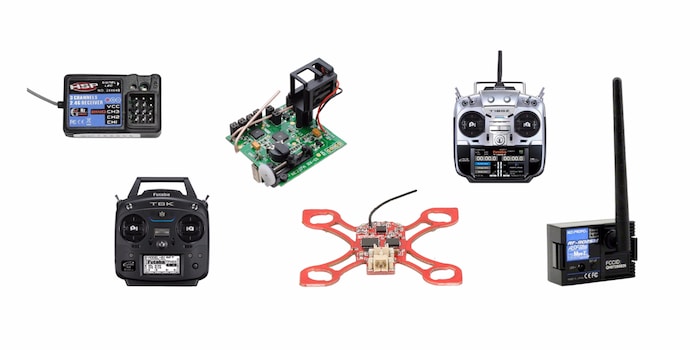

Principles from the RC remote control jungle
Radio frequency, channels and model memory: Here you can find out everything you need to know about RC receivers and RC remote controls. From basic information to detailed background knowledge, I'll give you everything you need to know about this topic.
The basis
The steering commands are sent to the receiver via the remote control, also known as the transmitter. The receiver is located in the RC model and is there to receive the signals from the transmitter, i.e. the remote control. Ready-to-race (RTR) and most almost-ready-to-race (ARR) models are supplied with a remote control and receiver. With kits, you have to buy the remote control and the matching receiver yourself. Even if you get the car RTR, it can't hurt to gain some basic knowledge about RC remote controls.
Important: Always switch on the remote control first and then the receiver, i.e. the RC model itself. When switching off, follow the reverse order, switch off the receiver first and then the transmitter.
The remote control and receiver must always use the same channel and frequency. In addition, the number of channels on the remote control must match the number of channels on the receiver. In other words, the remote control must have at least as many channels as the receiver has. You can therefore also control a 6-channel receiver with a 12-channel remote control. But then you can only use 6 channels of the remote control.
More detailed information on all these topics follows.
Digital vs. analogue radio connection
The commands are entered via the joystick on the remote control and then transmitted to the receiver in analogue or digital form, depending on the device. The frequency range indicates whether the receiver is digital or analogue: analogue devices transmit at 27 and 40 MHz, digital ones at 2.4 or even 5.8 GHz. However, analogue receivers are now largely obsolete and digital receivers, which receive in the 2.4 GHz frequency range, are the most common in model making.
The digital radio link allows coupling with the remote control. This has solved or significantly minimised many previous problems. For example, this system is resistant to low-frequency interference and channel duplication. Only the antennas and their cables are somewhat more sensitive here.
The receiver
The receiver processes the signals from the remote control and then forwards the commands to the servos or motor controllers. The receiver also supplies voltage and current to the servos. Due to these important tasks of the receiver, it is advisable to take care when handling it in order to avoid possible interference. The receiver should therefore be placed as far away as possible from the controller and motor. The antenna of the receiver should not be connected to carbon fibre or metal parts. The aerial should also not be shortened, tied or rolled up. Also avoid long servo cables.
The channels
In principle, the number of channels is the same as the number of control functions that a receiver or remote control has. This means that each channel controls one motor or servo. The number of channels should correspond to the number of controllable motors or servos. One unit is controlled per channel. Depending on what you want to control, you will need more or fewer channels. A simple RC car, for example, would require 2 channels: one to control the motor, and therefore the accelerator and brake, and one to control the servo that triggers the movement to the left or right. An RC aeroplane requires around 4 channels and if you equip your RC model with additional functions such as smoke or lights that you also want to control, you will need additional channels accordingly.
In our range you will find remote controls with up to 24 channels. You can see how many channels a remote control has by the number of joysticks and heads. You can see how many channels a receiver supports by the number of slots. In general, the number of slots minus one equals the number of channels. Why minus one? One of the slots is intended for the power supply. But don't worry: the slots are usually numbered and labelled for their respective purpose.
The remote control and the model memory
The number of model memories of a remote control indicates how many individual RC models can be operated with the same remote control. This allows you to save individual models whose respective data can be accessed when changing models. This is extremely practical if you own several RC models but only want one remote control. Of course, you won't be able to control two models at the same time. You can save up to 30 different models with this inexpensive remote control.

You may also be interested in this article
Ever since I was a kid, I’ve been crazy about scale modelling – this enthusiasm has stuck with me to this day. I also love technology, construction and anything I can invent or build. Apart from being a techie, I’m also a true travel fanatic.
Interesting facts about products, behind-the-scenes looks at manufacturers and deep-dives on interesting people.
Show all